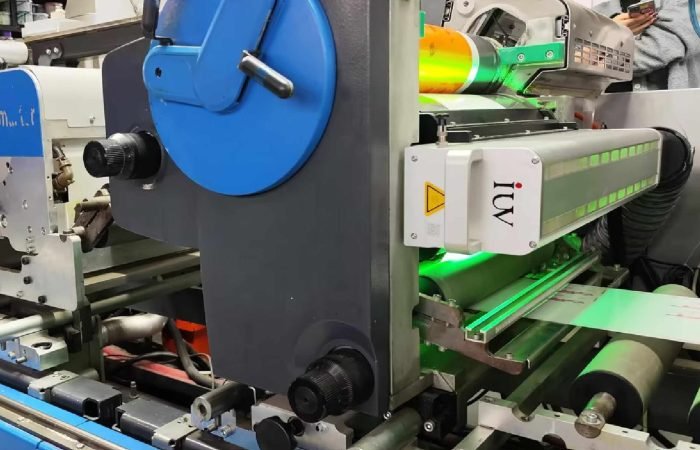The demand for high-volume label production has pushed printing technologies to evolve rapidly. LED UV offset printing emerges as a game-changer for manufacturers needing precision, speed, and environmental compliance. Unlike traditional methods requiring heat-intensive drying, this process uses ultraviolet light to instantly cure inks. The marriage of offset’s sharp detail reproduction with UV curing’s efficiency creates a powerhouse solution for labels requiring metallic finishes, vibrant Pantone matches, or intricate security features.
At its core, LED UV technology relies on specific photoinitiators in inks that react to narrow-spectrum light wavelengths. This differs from conventional mercury-vapor UV systems, eliminating warm-up times and reducing energy consumption by up to 70%. For label converters running 24/7 shifts, the immediate on/off capability of LED arrays means zero standby power waste. Press operators benefit from cooler substrate temperatures – critical when printing heat-sensitive materials like thin films or shrink sleeves.
Narrow web presses optimized for LED UV demonstrate particular advantages in label applications. A 10-color configuration might combine standard process colors with specialty stations for cold foil transfer, tactile varnishes, or scratch-off coatings. The instant curing between print units prevents ink trapping issues common in water-based flexo printing. One pharmaceutical manufacturer reduced waste by 18% after switching to LED UV offset for blister pack labels, citing improved ink adhesion on non-porous materials.
Comparing technologies reveals why UV offset gains ground over flexo and gravure for premium labels. While flexography dominates in long runs of simple designs, it struggles with halftone gradients below 150 lpi. A side-by-side test on wine labels showed UV offset achieving 1-98% dot reproduction versus flexo’s 3-95% range. The difference becomes critical for luxury products requiring photorealistic imagery. Gravure’s superior consistency comes at a steep cost – UV offset plates cost 90% less than engraved cylinders for job changeovers.
Material compatibility remains a key consideration. LED UV inks adhere exceptionally well to synthetic substrates like BOPP and PET, which absorb less ink than paper. A common challenge in pressure-sensitive label production – ink cracking during die-cutting – diminishes due to the cured ink film’s flexibility. converters report 30% fewer rejects on polyethylene labels compared to solvent-based systems. The technology also enables printing on thermal transfer ribbons without blocking issues during rewinding.
Energy consumption metrics reveal operational advantages. A typical 20-inch UV offset press consumes 15-18 kW during production, versus 25-30 kW for equivalent conventional drying systems. The elimination of ozone generators and mercury lamps reduces maintenance costs – LED arrays last 20,000 hours versus 1,000-2,000 hours for traditional UV bulbs. One label converter calculated a 14-month ROI after retrofitting their existing offset press with LED UV modules, factoring in energy savings and reduced downtime.
Environmental regulations increasingly favor UV curing technology. With 99% of ink components polymerizing during curing, VOC emissions drop to near-zero levels. This eliminates the need for costly afterburners or carbon filtration systems. Food-safe certification comes easier since cured UV inks don’t require additives like slip agents that might migrate. A dairy company transitioned to LED UV offset for ice cream container labels to meet updated FDA compliance standards.
Press configurations continue evolving to maximize LED UV’s potential. Hybrid models now integrate flexo stations for varnishing with offset units for fine detail. Servo-driven tension control maintains dimensional stability on thin films during instant curing. Advanced systems employ inline spectrophotometers to monitor color consistency across 400 fpm web speeds. The latest innovation – dual-wavelength LED systems – cure thick opaque whites and delicate tints with equal efficiency.
For converters debating technology investments, consider these application scenarios. UV offset shines in runs of 50,000-5 million labels requiring metallic inks, variable data, or complex overprinting. It underperforms for simple one-color tags on porous stock where flexo remains cost-effective. The sweet spot lies in premium products – cosmetics, craft beverages, electronics – where label aesthetics directly impact perceived value.
Future developments hint at expanded capabilities. Ink manufacturers are testing UV inks with 80% bio-based content without sacrificing cure speed. Press builders experiment with LED arrays emitting multiple wavelengths to handle emerging substrates like compostable films. As retail shifts toward smart packaging, UV’s ability to print conductive inks for NFC antennas positions it as an enabling technology.
The shift toward LED UV offset reflects broader industry trends – smaller batches, faster turnarounds, sustainable practices. A label printer serving automotive clients reduced ink inventory by 60% through UV’s color consistency across disparate jobs. Another targeting the craft beer market leveraged UV’s fast curing to implement just-in-time production, slashing warehousing costs.
Technical teams evaluating the transition should audit current workflows. Key metrics include substrate diversity, average run lengths, and quality rejection rates. Pilot testing on a 10-job sample often reveals hidden benefits – one converter discovered they could eliminate laminate layers through UV’s protective cured surface.
This technology isn’t a universal replacement, but a strategic tool for specific market segments. Its value proposition strengthens as brands demand shorter runs with premium finishes. The combination of offset’s precision and UV’s efficiency creates possibilities previously limited to screen printing or digital methods. For labels serving as primary brand differentiators, the investment justifies through enhanced shelf impact and production flexibility.
Those mastering LED UV offset positioning should highlight technical differentiators – say, 2-micron ink film uniformity or 300% faster curing than EB alternatives. Case studies prove particularly effective, like a health supplement company increasing sales 19% after switching to UV-printed metallic labels. As packaging becomes increasingly tied to consumer experience, the ability to deliver both visual brilliance and manufacturing efficiency positions converters as strategic partners rather than commodity suppliers.
The conversation around label printing technology keeps evolving, but one truth remains – in competitive markets, production capabilities directly influence brand success. The companies thriving today recognize that labels aren’t just informational tags, but canvases for storytelling. LED UV offset provides the brush to paint those stories with unprecedented clarity and efficiency.












